ECON 2: Comparing Liberal, Static, and Critical IPE Theories
VerifiedAdded on 2022/09/29
|7
|1639
|33
Essay
AI Summary
This essay delves into the realm of International Political Economy (IPE), exploring and comparing three key theoretical approaches: liberal, static, and critical theories. The introduction establishes IPE as a crucial sub-branch of international relations, focusing on the interplay between political and economic relations within and between states. The essay then proceeds to analyze the similarities shared by these theories. It highlights the liberal theory's emphasis on free trade and market mechanisms, the static theory's support for export promotion and controlled imports, and the critical approach's focus on global economic structures and power dynamics. The essay also discusses how these theories view the role of government, international organizations, and domestic interests in shaping international relations. Furthermore, the essay references key figures like Adam Smith, John Stuart Mill, and others who contributed to the development of these theories. The conclusion emphasizes the importance of national interest in an era of economic globalization, and how IPE theories can be applied to understand international trade and political participation.
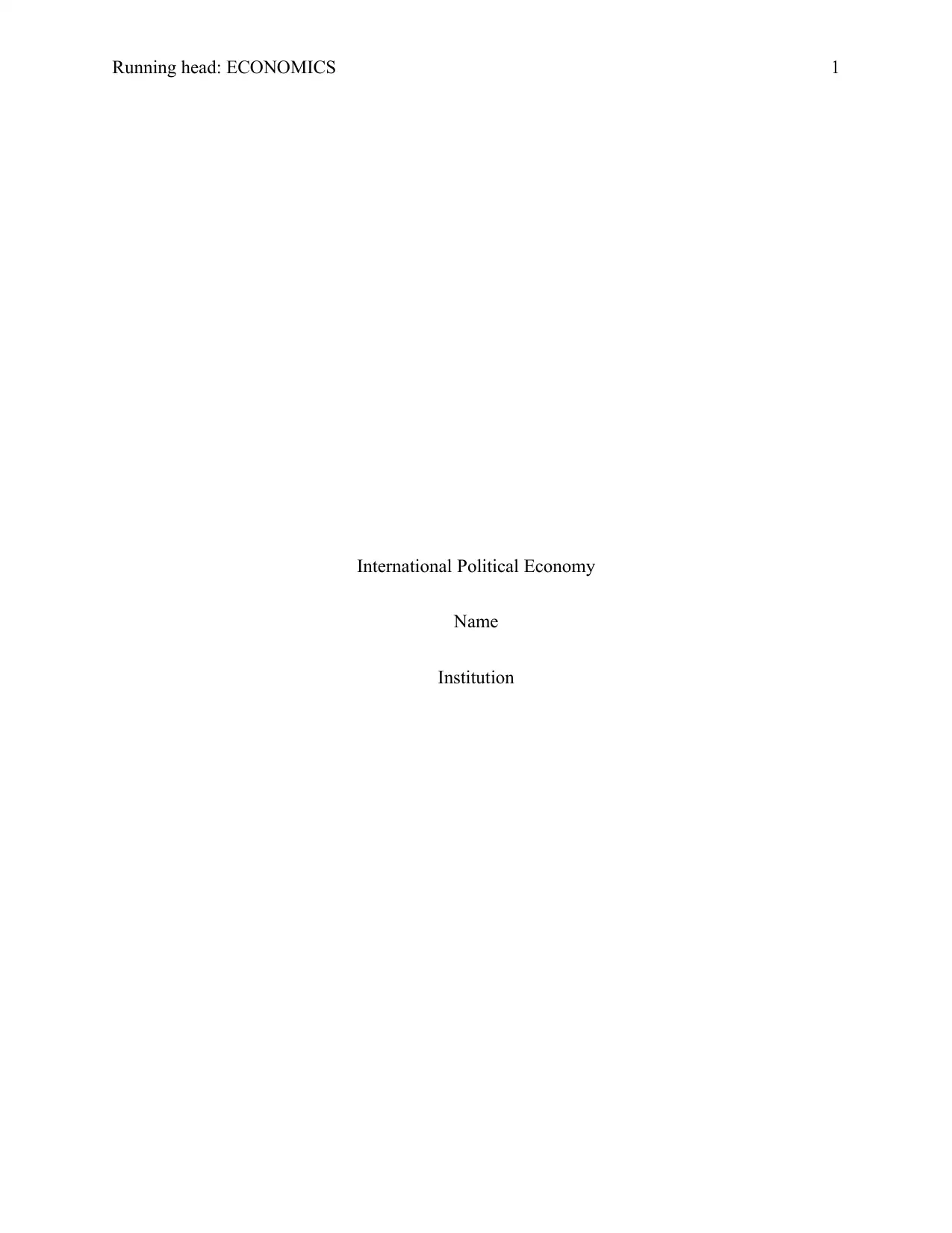
Running head: ECONOMICS 1
International Political Economy
Name
Institution
International Political Economy
Name
Institution
Paraphrase This Document
Need a fresh take? Get an instant paraphrase of this document with our AI Paraphraser
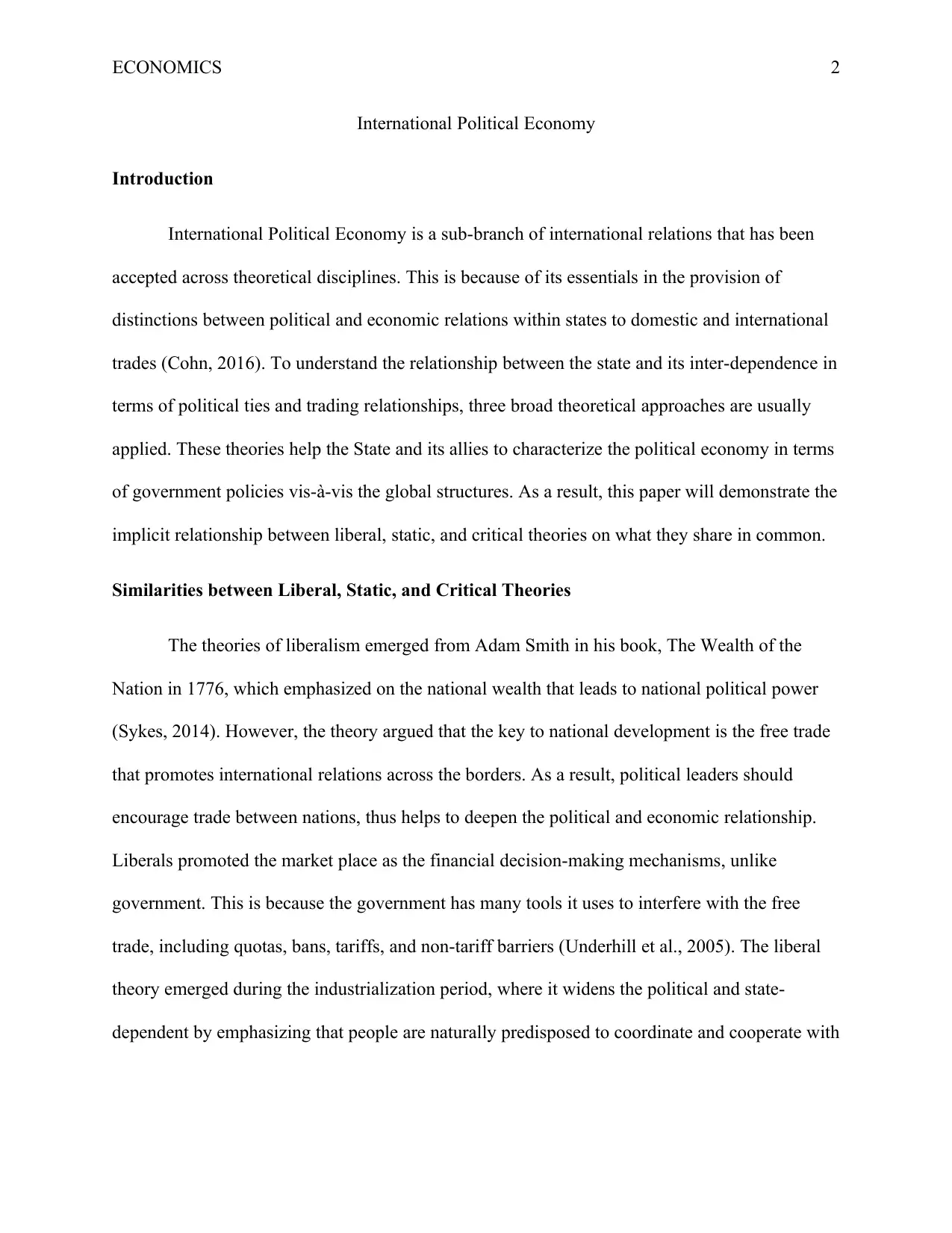
ECONOMICS 2
International Political Economy
Introduction
International Political Economy is a sub-branch of international relations that has been
accepted across theoretical disciplines. This is because of its essentials in the provision of
distinctions between political and economic relations within states to domestic and international
trades (Cohn, 2016). To understand the relationship between the state and its inter-dependence in
terms of political ties and trading relationships, three broad theoretical approaches are usually
applied. These theories help the State and its allies to characterize the political economy in terms
of government policies vis-à-vis the global structures. As a result, this paper will demonstrate the
implicit relationship between liberal, static, and critical theories on what they share in common.
Similarities between Liberal, Static, and Critical Theories
The theories of liberalism emerged from Adam Smith in his book, The Wealth of the
Nation in 1776, which emphasized on the national wealth that leads to national political power
(Sykes, 2014). However, the theory argued that the key to national development is the free trade
that promotes international relations across the borders. As a result, political leaders should
encourage trade between nations, thus helps to deepen the political and economic relationship.
Liberals promoted the market place as the financial decision-making mechanisms, unlike
government. This is because the government has many tools it uses to interfere with the free
trade, including quotas, bans, tariffs, and non-tariff barriers (Underhill et al., 2005). The liberal
theory emerged during the industrialization period, where it widens the political and state-
dependent by emphasizing that people are naturally predisposed to coordinate and cooperate with
International Political Economy
Introduction
International Political Economy is a sub-branch of international relations that has been
accepted across theoretical disciplines. This is because of its essentials in the provision of
distinctions between political and economic relations within states to domestic and international
trades (Cohn, 2016). To understand the relationship between the state and its inter-dependence in
terms of political ties and trading relationships, three broad theoretical approaches are usually
applied. These theories help the State and its allies to characterize the political economy in terms
of government policies vis-à-vis the global structures. As a result, this paper will demonstrate the
implicit relationship between liberal, static, and critical theories on what they share in common.
Similarities between Liberal, Static, and Critical Theories
The theories of liberalism emerged from Adam Smith in his book, The Wealth of the
Nation in 1776, which emphasized on the national wealth that leads to national political power
(Sykes, 2014). However, the theory argued that the key to national development is the free trade
that promotes international relations across the borders. As a result, political leaders should
encourage trade between nations, thus helps to deepen the political and economic relationship.
Liberals promoted the market place as the financial decision-making mechanisms, unlike
government. This is because the government has many tools it uses to interfere with the free
trade, including quotas, bans, tariffs, and non-tariff barriers (Underhill et al., 2005). The liberal
theory emerged during the industrialization period, where it widens the political and state-
dependent by emphasizing that people are naturally predisposed to coordinate and cooperate with
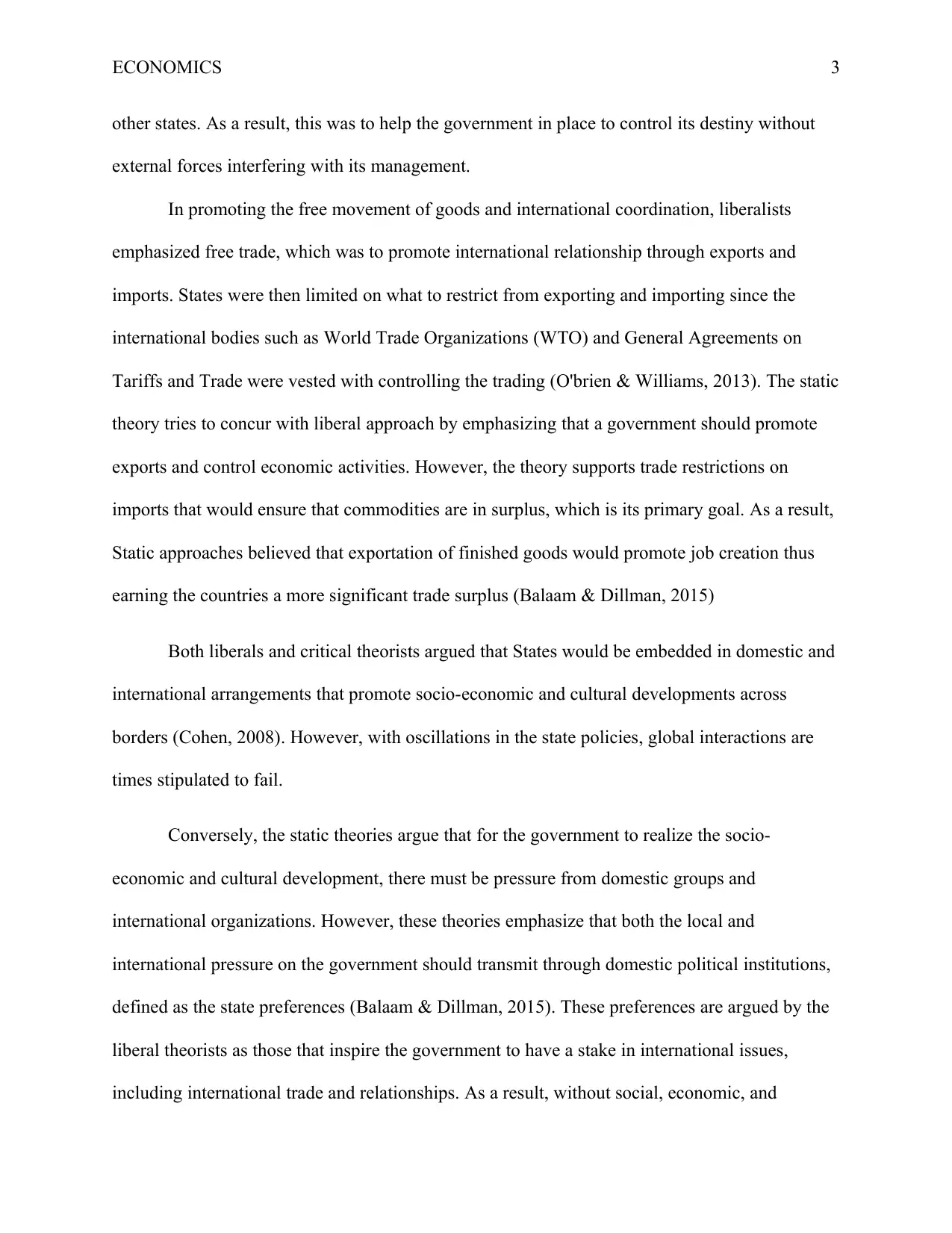
ECONOMICS 3
other states. As a result, this was to help the government in place to control its destiny without
external forces interfering with its management.
In promoting the free movement of goods and international coordination, liberalists
emphasized free trade, which was to promote international relationship through exports and
imports. States were then limited on what to restrict from exporting and importing since the
international bodies such as World Trade Organizations (WTO) and General Agreements on
Tariffs and Trade were vested with controlling the trading (O'brien & Williams, 2013). The static
theory tries to concur with liberal approach by emphasizing that a government should promote
exports and control economic activities. However, the theory supports trade restrictions on
imports that would ensure that commodities are in surplus, which is its primary goal. As a result,
Static approaches believed that exportation of finished goods would promote job creation thus
earning the countries a more significant trade surplus (Balaam & Dillman, 2015)
Both liberals and critical theorists argued that States would be embedded in domestic and
international arrangements that promote socio-economic and cultural developments across
borders (Cohen, 2008). However, with oscillations in the state policies, global interactions are
times stipulated to fail.
Conversely, the static theories argue that for the government to realize the socio-
economic and cultural development, there must be pressure from domestic groups and
international organizations. However, these theories emphasize that both the local and
international pressure on the government should transmit through domestic political institutions,
defined as the state preferences (Balaam & Dillman, 2015). These preferences are argued by the
liberal theorists as those that inspire the government to have a stake in international issues,
including international trade and relationships. As a result, without social, economic, and
other states. As a result, this was to help the government in place to control its destiny without
external forces interfering with its management.
In promoting the free movement of goods and international coordination, liberalists
emphasized free trade, which was to promote international relationship through exports and
imports. States were then limited on what to restrict from exporting and importing since the
international bodies such as World Trade Organizations (WTO) and General Agreements on
Tariffs and Trade were vested with controlling the trading (O'brien & Williams, 2013). The static
theory tries to concur with liberal approach by emphasizing that a government should promote
exports and control economic activities. However, the theory supports trade restrictions on
imports that would ensure that commodities are in surplus, which is its primary goal. As a result,
Static approaches believed that exportation of finished goods would promote job creation thus
earning the countries a more significant trade surplus (Balaam & Dillman, 2015)
Both liberals and critical theorists argued that States would be embedded in domestic and
international arrangements that promote socio-economic and cultural developments across
borders (Cohen, 2008). However, with oscillations in the state policies, global interactions are
times stipulated to fail.
Conversely, the static theories argue that for the government to realize the socio-
economic and cultural development, there must be pressure from domestic groups and
international organizations. However, these theories emphasize that both the local and
international pressure on the government should transmit through domestic political institutions,
defined as the state preferences (Balaam & Dillman, 2015). These preferences are argued by the
liberal theorists as those that inspire the government to have a stake in international issues,
including international trade and relationships. As a result, without social, economic, and
⊘ This is a preview!⊘
Do you want full access?
Subscribe today to unlock all pages.

Trusted by 1+ million students worldwide
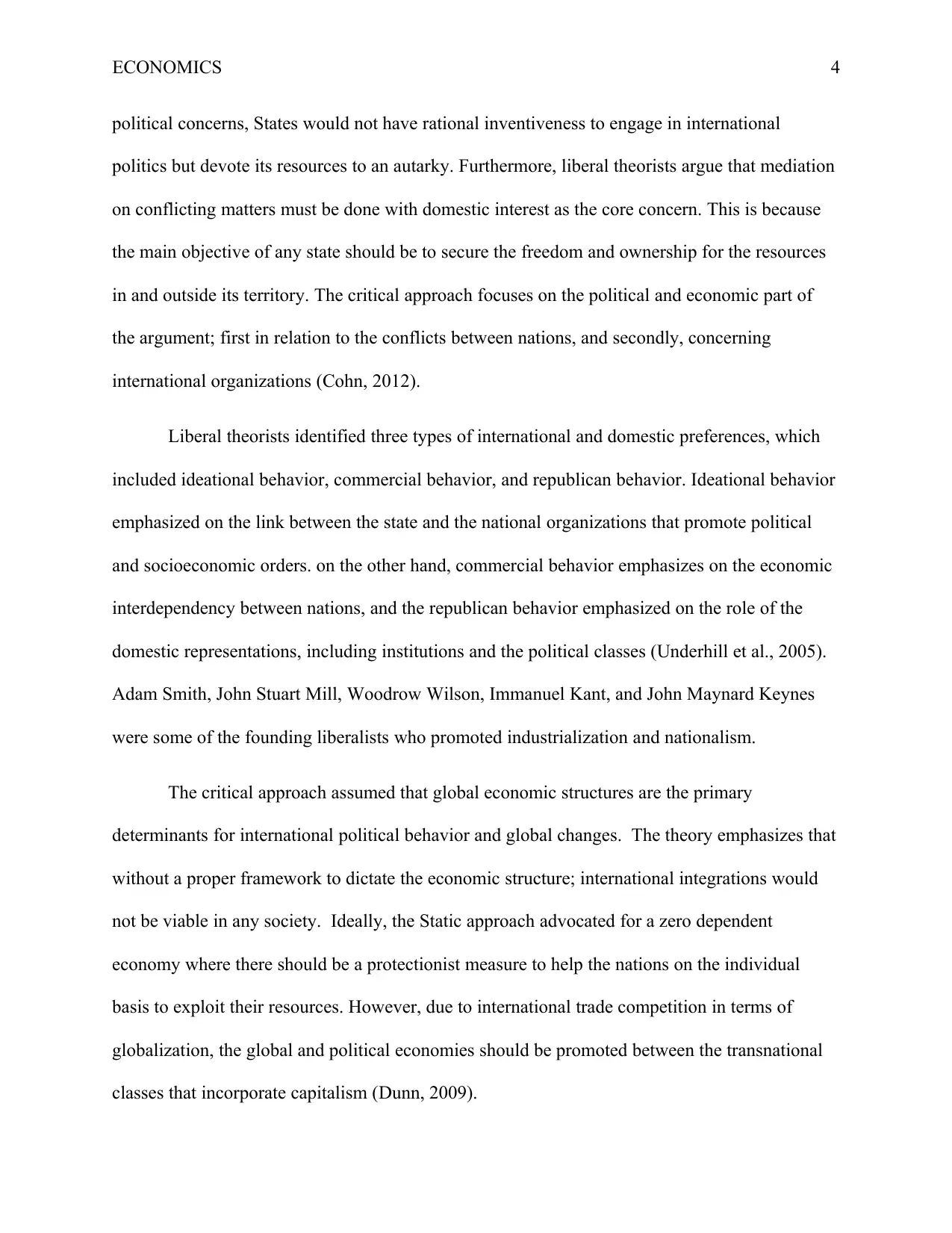
ECONOMICS 4
political concerns, States would not have rational inventiveness to engage in international
politics but devote its resources to an autarky. Furthermore, liberal theorists argue that mediation
on conflicting matters must be done with domestic interest as the core concern. This is because
the main objective of any state should be to secure the freedom and ownership for the resources
in and outside its territory. The critical approach focuses on the political and economic part of
the argument; first in relation to the conflicts between nations, and secondly, concerning
international organizations (Cohn, 2012).
Liberal theorists identified three types of international and domestic preferences, which
included ideational behavior, commercial behavior, and republican behavior. Ideational behavior
emphasized on the link between the state and the national organizations that promote political
and socioeconomic orders. on the other hand, commercial behavior emphasizes on the economic
interdependency between nations, and the republican behavior emphasized on the role of the
domestic representations, including institutions and the political classes (Underhill et al., 2005).
Adam Smith, John Stuart Mill, Woodrow Wilson, Immanuel Kant, and John Maynard Keynes
were some of the founding liberalists who promoted industrialization and nationalism.
The critical approach assumed that global economic structures are the primary
determinants for international political behavior and global changes. The theory emphasizes that
without a proper framework to dictate the economic structure; international integrations would
not be viable in any society. Ideally, the Static approach advocated for a zero dependent
economy where there should be a protectionist measure to help the nations on the individual
basis to exploit their resources. However, due to international trade competition in terms of
globalization, the global and political economies should be promoted between the transnational
classes that incorporate capitalism (Dunn, 2009).
political concerns, States would not have rational inventiveness to engage in international
politics but devote its resources to an autarky. Furthermore, liberal theorists argue that mediation
on conflicting matters must be done with domestic interest as the core concern. This is because
the main objective of any state should be to secure the freedom and ownership for the resources
in and outside its territory. The critical approach focuses on the political and economic part of
the argument; first in relation to the conflicts between nations, and secondly, concerning
international organizations (Cohn, 2012).
Liberal theorists identified three types of international and domestic preferences, which
included ideational behavior, commercial behavior, and republican behavior. Ideational behavior
emphasized on the link between the state and the national organizations that promote political
and socioeconomic orders. on the other hand, commercial behavior emphasizes on the economic
interdependency between nations, and the republican behavior emphasized on the role of the
domestic representations, including institutions and the political classes (Underhill et al., 2005).
Adam Smith, John Stuart Mill, Woodrow Wilson, Immanuel Kant, and John Maynard Keynes
were some of the founding liberalists who promoted industrialization and nationalism.
The critical approach assumed that global economic structures are the primary
determinants for international political behavior and global changes. The theory emphasizes that
without a proper framework to dictate the economic structure; international integrations would
not be viable in any society. Ideally, the Static approach advocated for a zero dependent
economy where there should be a protectionist measure to help the nations on the individual
basis to exploit their resources. However, due to international trade competition in terms of
globalization, the global and political economies should be promoted between the transnational
classes that incorporate capitalism (Dunn, 2009).
Paraphrase This Document
Need a fresh take? Get an instant paraphrase of this document with our AI Paraphraser
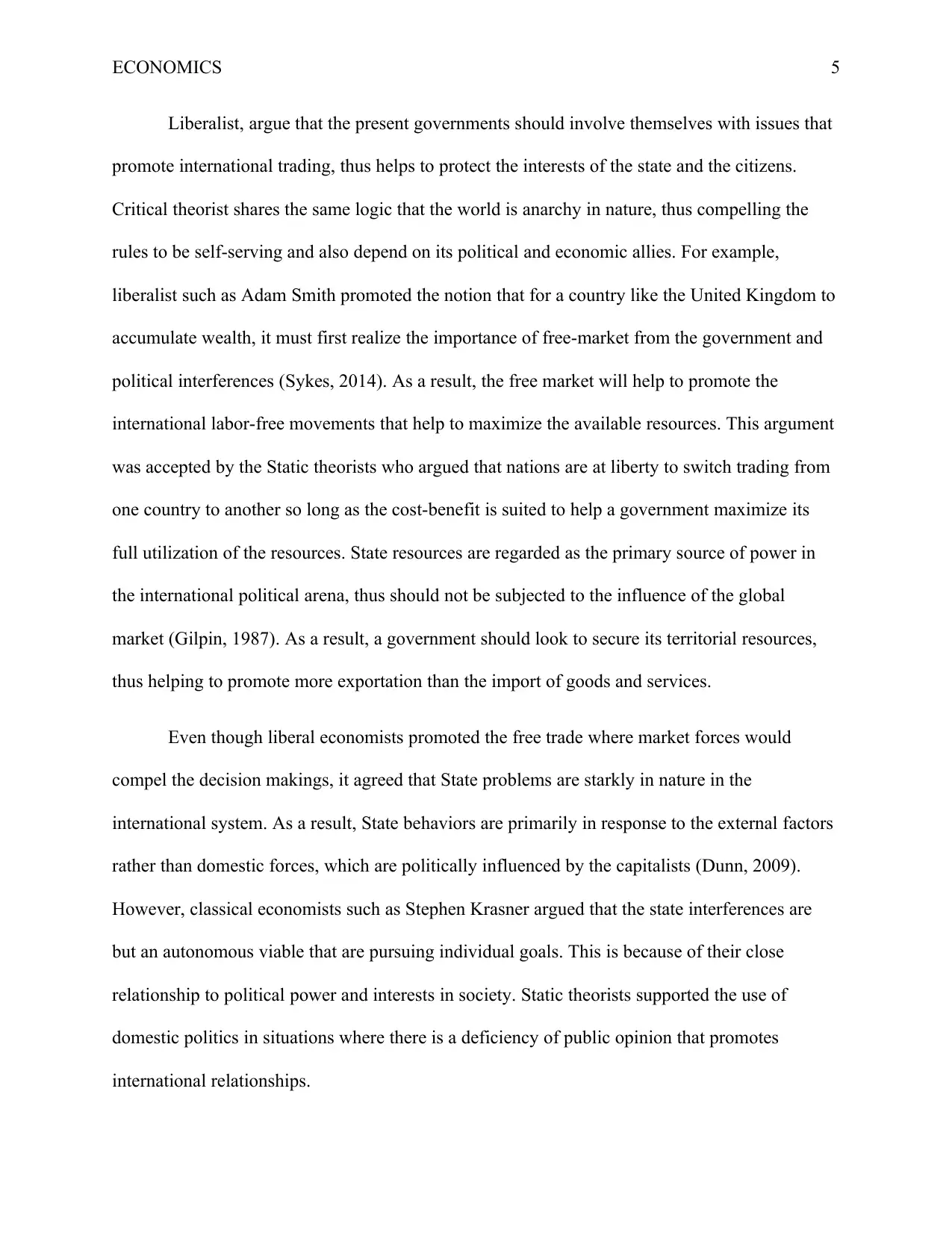
ECONOMICS 5
Liberalist, argue that the present governments should involve themselves with issues that
promote international trading, thus helps to protect the interests of the state and the citizens.
Critical theorist shares the same logic that the world is anarchy in nature, thus compelling the
rules to be self-serving and also depend on its political and economic allies. For example,
liberalist such as Adam Smith promoted the notion that for a country like the United Kingdom to
accumulate wealth, it must first realize the importance of free-market from the government and
political interferences (Sykes, 2014). As a result, the free market will help to promote the
international labor-free movements that help to maximize the available resources. This argument
was accepted by the Static theorists who argued that nations are at liberty to switch trading from
one country to another so long as the cost-benefit is suited to help a government maximize its
full utilization of the resources. State resources are regarded as the primary source of power in
the international political arena, thus should not be subjected to the influence of the global
market (Gilpin, 1987). As a result, a government should look to secure its territorial resources,
thus helping to promote more exportation than the import of goods and services.
Even though liberal economists promoted the free trade where market forces would
compel the decision makings, it agreed that State problems are starkly in nature in the
international system. As a result, State behaviors are primarily in response to the external factors
rather than domestic forces, which are politically influenced by the capitalists (Dunn, 2009).
However, classical economists such as Stephen Krasner argued that the state interferences are
but an autonomous viable that are pursuing individual goals. This is because of their close
relationship to political power and interests in society. Static theorists supported the use of
domestic politics in situations where there is a deficiency of public opinion that promotes
international relationships.
Liberalist, argue that the present governments should involve themselves with issues that
promote international trading, thus helps to protect the interests of the state and the citizens.
Critical theorist shares the same logic that the world is anarchy in nature, thus compelling the
rules to be self-serving and also depend on its political and economic allies. For example,
liberalist such as Adam Smith promoted the notion that for a country like the United Kingdom to
accumulate wealth, it must first realize the importance of free-market from the government and
political interferences (Sykes, 2014). As a result, the free market will help to promote the
international labor-free movements that help to maximize the available resources. This argument
was accepted by the Static theorists who argued that nations are at liberty to switch trading from
one country to another so long as the cost-benefit is suited to help a government maximize its
full utilization of the resources. State resources are regarded as the primary source of power in
the international political arena, thus should not be subjected to the influence of the global
market (Gilpin, 1987). As a result, a government should look to secure its territorial resources,
thus helping to promote more exportation than the import of goods and services.
Even though liberal economists promoted the free trade where market forces would
compel the decision makings, it agreed that State problems are starkly in nature in the
international system. As a result, State behaviors are primarily in response to the external factors
rather than domestic forces, which are politically influenced by the capitalists (Dunn, 2009).
However, classical economists such as Stephen Krasner argued that the state interferences are
but an autonomous viable that are pursuing individual goals. This is because of their close
relationship to political power and interests in society. Static theorists supported the use of
domestic politics in situations where there is a deficiency of public opinion that promotes
international relationships.
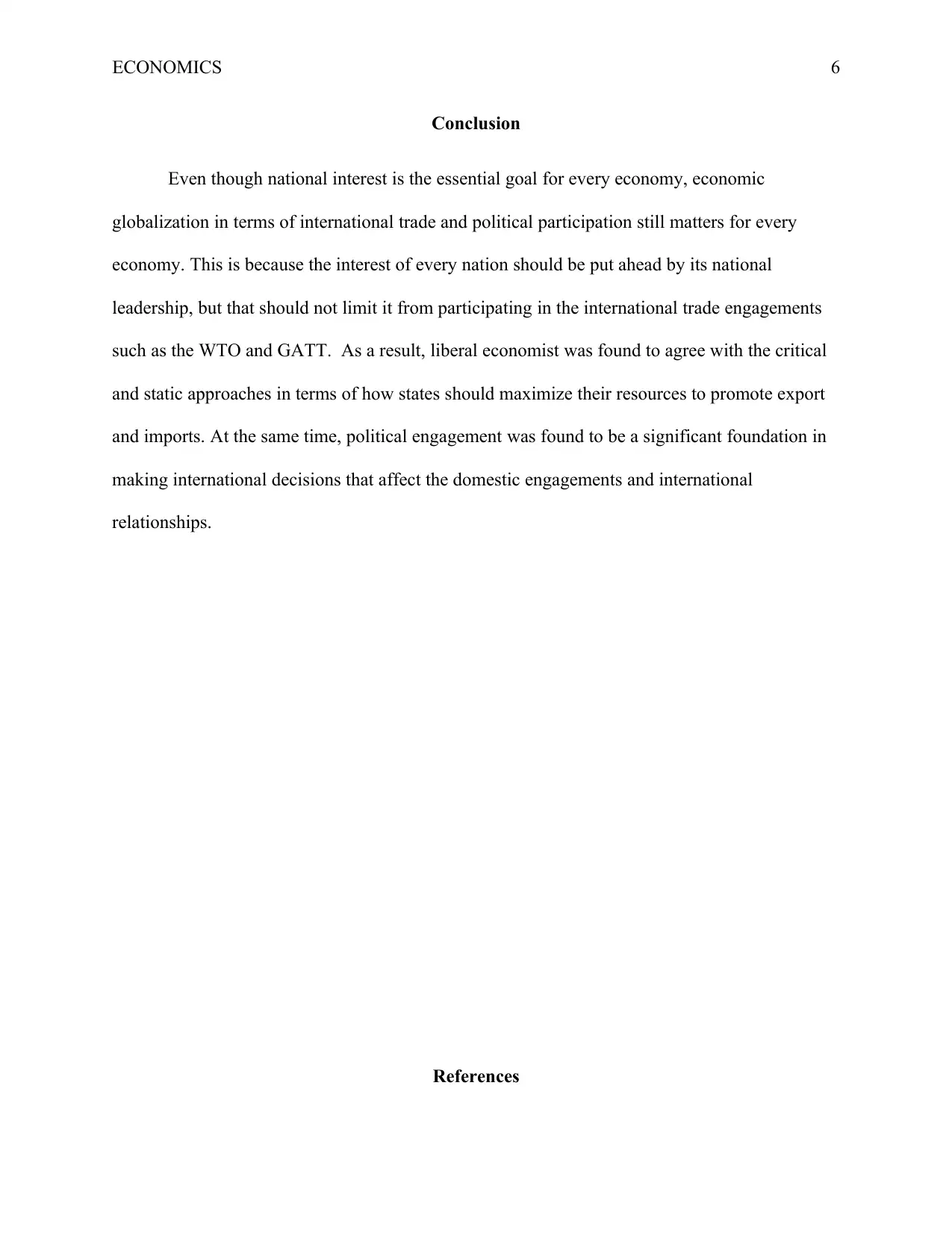
ECONOMICS 6
Conclusion
Even though national interest is the essential goal for every economy, economic
globalization in terms of international trade and political participation still matters for every
economy. This is because the interest of every nation should be put ahead by its national
leadership, but that should not limit it from participating in the international trade engagements
such as the WTO and GATT. As a result, liberal economist was found to agree with the critical
and static approaches in terms of how states should maximize their resources to promote export
and imports. At the same time, political engagement was found to be a significant foundation in
making international decisions that affect the domestic engagements and international
relationships.
References
Conclusion
Even though national interest is the essential goal for every economy, economic
globalization in terms of international trade and political participation still matters for every
economy. This is because the interest of every nation should be put ahead by its national
leadership, but that should not limit it from participating in the international trade engagements
such as the WTO and GATT. As a result, liberal economist was found to agree with the critical
and static approaches in terms of how states should maximize their resources to promote export
and imports. At the same time, political engagement was found to be a significant foundation in
making international decisions that affect the domestic engagements and international
relationships.
References
⊘ This is a preview!⊘
Do you want full access?
Subscribe today to unlock all pages.

Trusted by 1+ million students worldwide
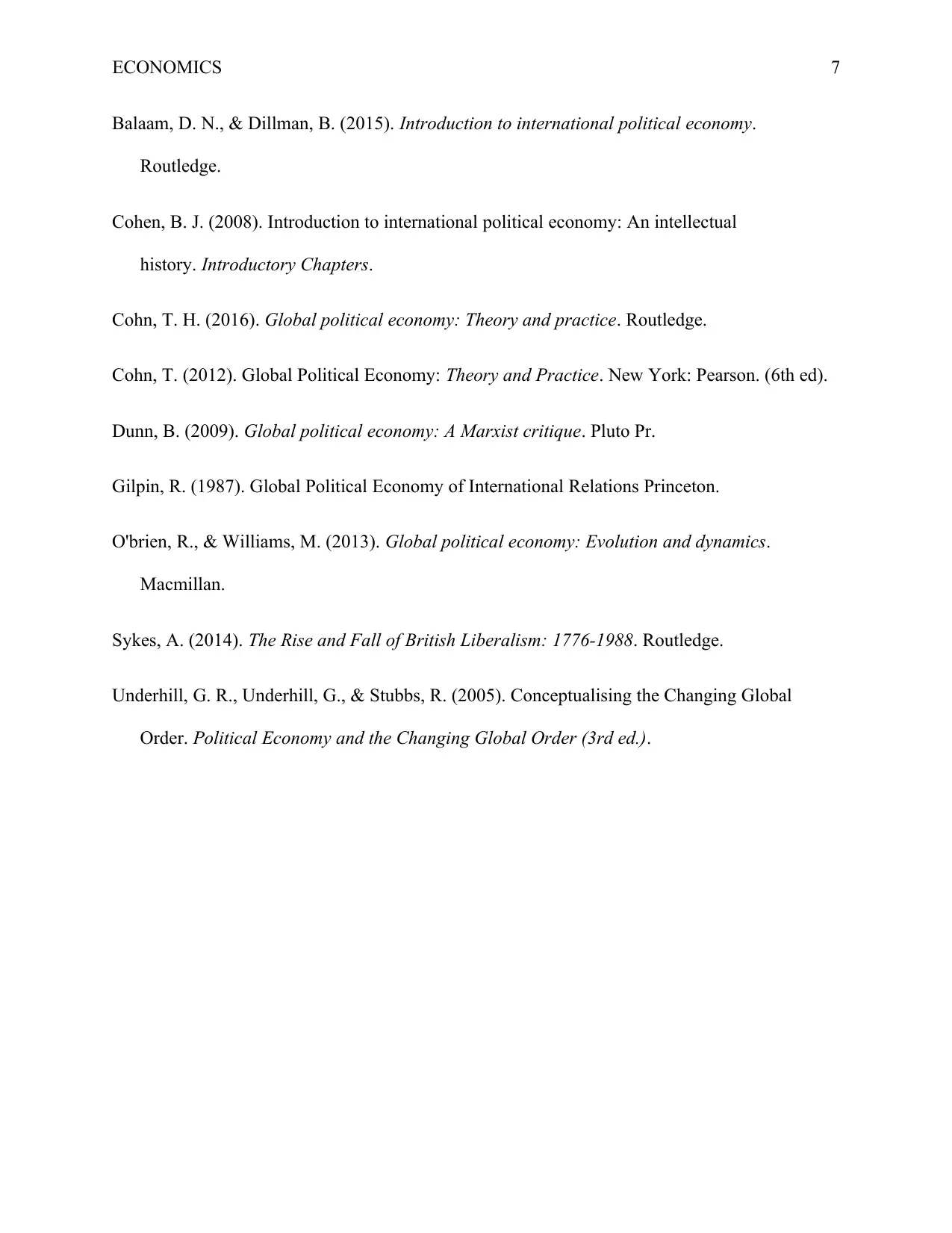
ECONOMICS 7
Balaam, D. N., & Dillman, B. (2015). Introduction to international political economy.
Routledge.
Cohen, B. J. (2008). Introduction to international political economy: An intellectual
history. Introductory Chapters.
Cohn, T. H. (2016). Global political economy: Theory and practice. Routledge.
Cohn, T. (2012). Global Political Economy: Theory and Practice. New York: Pearson. (6th ed).
Dunn, B. (2009). Global political economy: A Marxist critique. Pluto Pr.
Gilpin, R. (1987). Global Political Economy of International Relations Princeton.
O'brien, R., & Williams, M. (2013). Global political economy: Evolution and dynamics.
Macmillan.
Sykes, A. (2014). The Rise and Fall of British Liberalism: 1776-1988. Routledge.
Underhill, G. R., Underhill, G., & Stubbs, R. (2005). Conceptualising the Changing Global
Order. Political Economy and the Changing Global Order (3rd ed.).
Balaam, D. N., & Dillman, B. (2015). Introduction to international political economy.
Routledge.
Cohen, B. J. (2008). Introduction to international political economy: An intellectual
history. Introductory Chapters.
Cohn, T. H. (2016). Global political economy: Theory and practice. Routledge.
Cohn, T. (2012). Global Political Economy: Theory and Practice. New York: Pearson. (6th ed).
Dunn, B. (2009). Global political economy: A Marxist critique. Pluto Pr.
Gilpin, R. (1987). Global Political Economy of International Relations Princeton.
O'brien, R., & Williams, M. (2013). Global political economy: Evolution and dynamics.
Macmillan.
Sykes, A. (2014). The Rise and Fall of British Liberalism: 1776-1988. Routledge.
Underhill, G. R., Underhill, G., & Stubbs, R. (2005). Conceptualising the Changing Global
Order. Political Economy and the Changing Global Order (3rd ed.).
1 out of 7
Related Documents
Your All-in-One AI-Powered Toolkit for Academic Success.
+13062052269
info@desklib.com
Available 24*7 on WhatsApp / Email
![[object Object]](/_next/static/media/star-bottom.7253800d.svg)
Unlock your academic potential
Copyright © 2020–2025 A2Z Services. All Rights Reserved. Developed and managed by ZUCOL.





